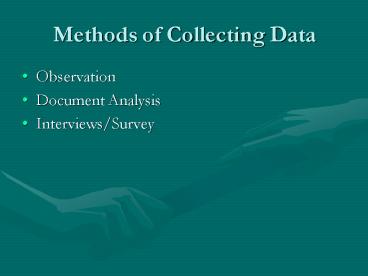Methods of Collecting Data - PowerPoint PPT Presentation
1 / 10
Title:
Methods of Collecting Data
Description:
... in a memo to President Lyndon Johnson, suggests White House action following ... Senator Douglas has been in touch with Mayor Daley and Senator Douglas just ... – PowerPoint PPT presentation
Number of Views:140
Avg rating:3.0/5.0
Title: Methods of Collecting Data
1
Methods of Collecting Data
- Observation
- Document Analysis
- Interviews/Survey
2
Document Analysis
- Episodic Records
- Records that are produced and preserved in a more
casual, personal and accidental manner - Personal diaries, memoirs, correspondence
- Episodic Records
3
Episodic Records (Example)
- Studying the government response to civil unrest
in the United States (Hypothesis Mass Unrest is
positively related to welfare expansion) - HEW secretary Joseph Califano, in a memo to
President Lyndon Johnson, suggests White House
action following major rioting in Chicago in July
of 1966. - The situation in Chicago continues to
deteriorate. Senator Douglas has been in touch
with Mayor Daley and Senator Douglas just called
me and asked that we put together a package to
speed up Federal grants in public housing and
on-the-job training programs that are now pending
in the Departments. In addition, he asked if
there were any assistance we could make with
respect to getting projects, such as recreation
areas and swimming facilities, started
rapidly...If you approve I will tell Daley that
we will do all we can to help him with Federal
programs, consistent, of course, with entitlement
under existing laws and regulations and in a
manner that does not put a premium on riots.
4
The Running Record
- More likely to be produced by organizations (esp.
govt) - Carefully stored, easily accessed, often
available over long periods of time - Some frequently used sources
- U.S. Government (Census Bureau, BJS), State
governments, America Votes (CQ), OECD,
Statistical Abstract of the U.S., media reports
5
The Running Record (An Example)
- Variables used in The Conditional Effect of
Violence as a Political Tactic Mass Insurgency,
Electoral Context, and Welfare Generosity in the
United States. (AJPS, Jan. 1997)
6
The Running Record (An Example)
- Appendix B Data Sources for Variables Used in
Analysis - AFDC Recipients. Total AFDC recipients, per one
million population, December of each year.
Recipients are individuals, not families, and
include children. Data obtained from Social
Security Bulletin, various years. - Insurgency. Data were obtained from a number of
different sources, including the New York Times,
the Kerner Report, Riot Data Review published by
the Lemberg Center for the Study of Violence,
Facts on File, and Congressional Quarterly. Data
were collected for a total of 923 events, all
occurring during the years 1962-1974. - Per Capita Income, Per capita State and Local
Government Tax Revenue, State Population,
Democratic Vote for Governor, Party Control of
State Legislatures. Yearly data obtained for each
variable from the Statistical Abstract of the
United States. - Number of female-headed families below poverty.
State data are available for 1959, 1969, and 1979
from the decennial census. Data for intervening
years are estimates assuming constant change
(linear interpolation). National data reported
in the text are from the Census Bureau's Current
Population Reports (P60-185). All data include
only those families with children. - Unemployment. State unemployment data were
obtained for every year, and represent an average
of monthly figures. Data published by the United
States Department of Labor, Employment and
Training Report of the President, 1971 and 1977,
and Geographic Profiles of Employment and
Unemployment. - Electoral Power. Detailed historical accounts
of state reapportionment efforts are reported by
the National Municipal League, in Apportionment
in the Nineteen Sixties. Information on the
timing of elections and convening of legislatures
during the l960's was obtained from the Book of
the States, published by the Council of State
Governments. - Black Population. Data are available at the
state level for years 1960, 1970, 1975 and 1980,
from the U.S. Census Bureau. Data for intervening
years are estimated assuming constant change
(linear interpolation). - Medicaid Data. Annual number of unduplicated
recipients, reported in Medicaid Statistics, FY
19XX. - Residency Requirements. This information is
reported in Characteristics of State Public
Assistance Plans Under the Social Security Act,
published by the U.S. Department of Health,
Education and Welfare.
7
Potential Problems with Running Record Data
- Inconsistency over time
- In how things are measured
- In availability
8
Content Analysis
- The process of deriving numerical data from
nonnumerical written records - Enables the researcher to take verbal,
nonquantitative records and transform it into
quantitative data - Examples most often seen in media research
often used to analyze speeches
9
Content Analysis (Example)
- Measuring Party Ideology in Western European
Democracies (1946-1998) - Used party manifestoes (platforms) to determine
ideology of political parties
10
(No Transcript)































